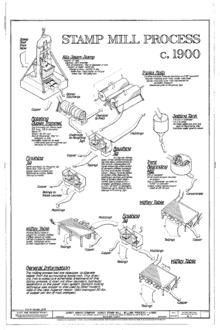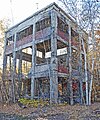|
Quincy Mining Company Stamp Mills Historic District
 The Quincy Mining Company Stamp Mills Historic District is a historic stamp mill (used to crush copper-bearing rock, separating the copper ore from surrounding rock) located on M-26 near Torch Lake, just east of Mason in Osceola Township.[2] It was listed on the National Register of Historic Places in 2007.[1] Original stamp mill (1860–1888) The original Quincy Stamp Mill was built in 1860 on Portage Lake[2] in Hancock, close to the Quincy Mine.[3] This facility, however, dumped an enormous amount of sand tailings into the lake, and the sand soon threatened to encroach on the navigable channel of the lake.[3] In the mid-1880s, the federal government set minimum harbor lines and stiff penalties for breaching them,[4] and eventually filed suit against the Quincy Mine for dumping in Portage Lake.[5] In addition, Quincy was in the process of acquiring the nearby Pewabic Mine, and management knew they would need to increase the company's stamping capacity.[6] Stamp mills require a large amount of water to operate, and so are invariably located near a large body of water; this limited the range of sites in which a new mill could be placed.[7] After some analysis, the Quincy management decided on Torch Lake as the site for the new mill and purchased 300 acres on the shore,[5] some six miles east of the previous location.[3] Construction of stamp mill (1888–1894)Work began on the new stamp mill in 1888.[2] The first building constructed was a boarding house, followed by a dock, cistern, and foundations for other buildings.[8] In 1889, six substantial frame buildings were constructed on site, as well as a railway connecting the stamp mill to the mine, and stamping equipment was installed.[8] Mill number one was a wooden structure measuring 198 feet by 120 feet.[9] The pump and boiler house were located on the south side of the roadway that is now M-26.[9] It was a stone structure measuring 154 feet by 56 feet.[10] An elevated conduit carried water and steam over the road to the mill, and handling facilities were built at the dock.[10] The facility was completed and opened for milling in 1890.[3][8] The site originally had two stamps; a third was added immediately after opening,[9] and two more were added in 1892.[2] More structures were added to the site over time, beginning with extensions to the dock in 1890 and 1891, an addition to the boiler house in 1891,[11] and additions to the mill in 1891 and 1892.[12] In all, the Quinct Mine spent $457,000 between 1888 and 1894 in constructing and equipping their new mill site, of which $182,000 went to the mill and its stamping equipment.[13] Second mill and additions (1894–1922)However, as early as 1894, mine production outstripped the capacity of the mill, and a new mill was planned.[14] The second stamp mill was built just north of the first;[2] this mill was an iron-framed structure measuring 132 feet by 216 feet.[15] It was constructed in 1899 by the Wisconsin Bridge and Iron Company at a cost of $22,450.[15] The second mill opened in late 1900 with three mills.[14][15] To service the additional capacity, new boiler and pump house buildings were also constructed.[16] Over the next two decades, minor alterations were made to the structures of the complex (including the erection of a new 175-foot smokestack for the boilerhouse in 1916)[17] while the milling process and machinery were continuously refined. However, the rise in the price of copper during World War I provided both impetus and resources for expansion of the site.[18] Reinforced concrete and brick additions to both stamp mills were constructed in 1919;[19] the addition to mill no. 1 was 123 feet by 215 feet, and the addition to mill no. 2 was 91 feet by 132 feet.[18] The additions were equipped and functioning by 1920.[19] The mill also changed their production of electrical power, building a structure to house a new turbine near mill no. 1.[20] Construction on the new building, a brick structure measuring 36 feet by 38 feet by 45 feet high, began in 1921; the turbine was online in 1923.[21]
Decline (1922 – present)However, the mill began to decline after the end of the war. In 1922, the second mill was closed.[19] Additional equipment was installed in mill no. 1 as technology improved, including labor-saving devices installed in 1929 and 1930.[22] However, the Great Depression hit the mining industry hard, and the Quincy Mine closed in 1931, shuttering the Stamp Mills.[22] As the Depression wound onward, copper prices rebounded, and the mine and mills were refurbished in late 1937 and re-opened on a limited scale in early 1938.[23] However, the mine was only barely profitable, and after World War II ended, and with it the price guarantees from the federal government, the mine and stamp mills closed permanently.[24] Mill number two was demolished early,[3] as well as the original portions of mill number one, but the later additions to mill number one remain.
Further reading
References
|
|||||||||||||||||||||||||||||












